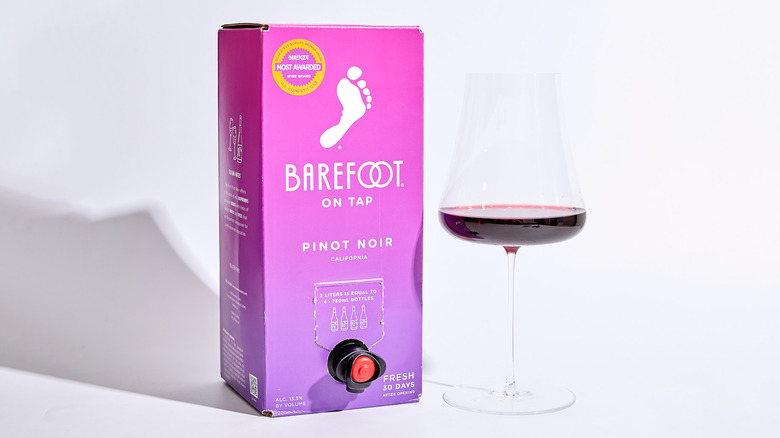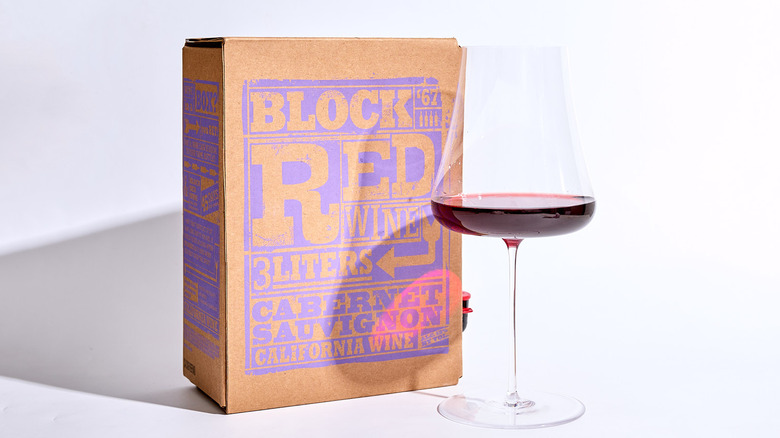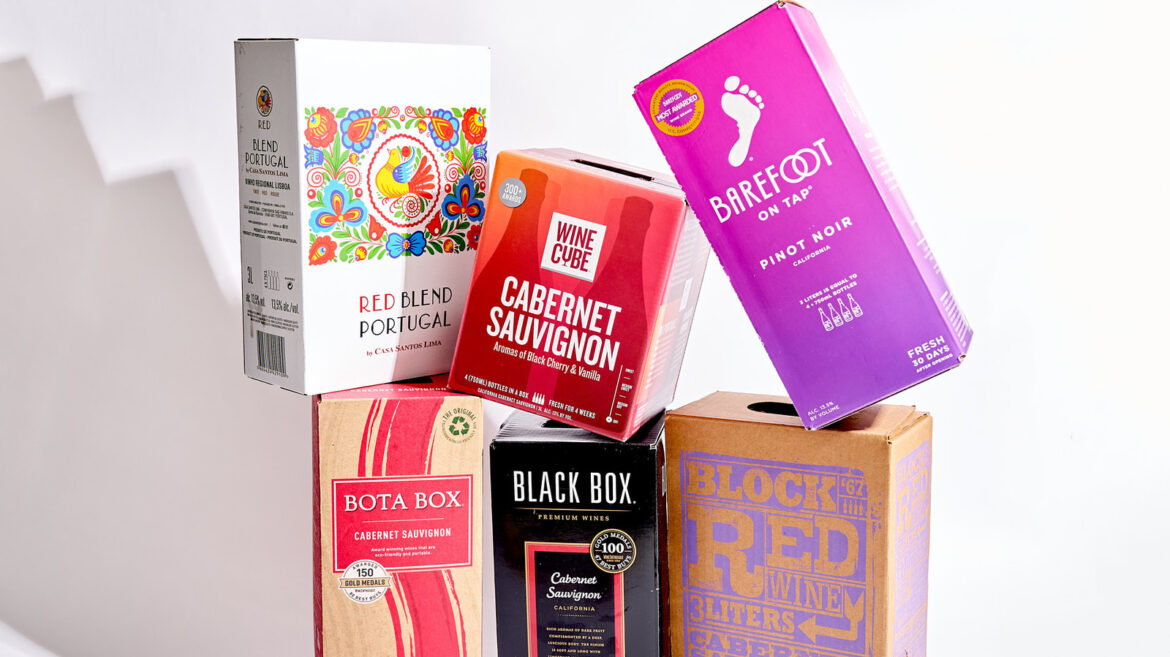
Michelle McGlinn/Chowhound
If you have some reservations about wine in a box, you aren’t alone. For centuries, wine has been stored in glass bottles as a way to properly preserve and age the delicate liquid within. The method has become synonymous with quality, and despite advancements in bottling, canning, and boxing, it still remains the best way to store wine — especially long-term. For casual occasions, though, there’s nothing wrong with boxed wine — in fact, there are many reasons to choose it over a bottle. The spouted design makes it easy to pour glasses without the commitment of opening a full bottle, and the tightly enclosed plastic prevents oxidation even weeks after opening. Sure, it might not be the first thing you’d gift to a friend or arrive with to a dinner party. For sipping at home, at tailgates, or by the pool, however, it’s a great way to enjoy an easy, glass-free pour.
What used to be a market dominated by average-at-best Franzia is now fairly robust with options, with even a few reputable wineries trying their hand at the cardboard liters. Filled with 3 liters of wine (or 20 glasses per box), it can be hard to decide which wine to commit to for a few weeks’ worth of drinking. To help you choose which wine to keep on your counter, I sipped from six of the most popular boxed red wines on the shelves, examining their aroma, flavor, acidity, and mouthfeel, ranking them accordingly from worst to best.
6. Barefoot Pinot Noir

Michelle McGlinn/Chowhound
You’d be hard-pressed to find someone who drinks wine and doesn’t recognize the brightly colored footprint label that is Barefoot Cellars. Known for being one of the most affordable bottles on the market, the wine has a reputation for being straightforward and uncomplicated — in other words, not particularly good. While it far surpasses wines that are potently undrinkable, the wine is generally sweet, fruity, and a little artificial-tasting, a little bit like a grape juice that has slightly fermented. For cooking, making sangria, or serving a crowd, this might be fine — but ultimately, may not be worth buying three liters’ worth of.
Pinot noir is usually a wine that is complex, dry, low-tannin, and medium-bodied, with a harmony of both fruity and earthy flavors. It’s a hard sell for a boxed wine being that it tastes best when given time to age, which can’t be done in the low shelf life of a boxed variety. The Barefoot version may be a good example of why this is true; the aroma is tart, sharp, and almost bitter, and the taste has a drying astringency that goes far beyond what is typical, even for tart American pinot noirs. The wine does have a fruity flavor of cherry and raspberry, and with its sugary sweetness, would likely make a great sangria when paired with ingredients that can balance the tannic dryness. A wine I’d likely avoid just for sipping, it ranks last on my list compared to more complex, smoother reds.
5. Target Wine Cube Cabernet Sauvignon

Michelle McGlinn/Chowhound
Target has one of the better alcohol selections among grocery stores, offering super-affordable options in a particularly accessible way. Target’s version of boxed wine comes in the form of the Wine Cube, which comes in several varietals from red blend to chardonnay. Tasting the Wine Cube cabernet sauvignon confirmed my suspicions that Barefoot’s boxed wine tasted more like a cabernet than a pinot; the two taste very similar, and lean much more towards the typical flavors of cabernet. The Wine Cube cabernet sauvignon pours as a medium-bodied, slightly more purple-hued color than the Barefoot pinot, and right away, has a noticeably smoother, more buttery aroma. Beyond that, though, the two have similar tastes and mouthfeels, both with notes of cherry and a hint of vanilla. Why I ranked Wine Cube above barefoot is because of its smooth finish and bright, fruity flavor, which lacks the sharpness of the pinot noir. It’s smooth, buttery, and fruity, making it a fun, drinkable wine.
To its credit, Wine Cube advertises itself as a “seriously fun wine,” which is precisely what boxed wine is meant for and how this wine comes across. It isn’t complex and there isn’t necessarily a great deal of depth, which makes it fun for parties or casual events, but not a wine I’d pair regularly with meals. Because other wines on the list offer a more interesting wine that I’d happily keep around for daily sipping, Target’s Wine Cube ranks lower on the list as a fine — but passable — option.
4. Casa Santos Lima Red Blend

Michelle McGlinn/Chowhound
While I enjoyed my tasting of Casa Santos Lima Red Blend, I really wanted to love this wine more than I did. A budget wine that is Portuguese in origin, the box is far different than any other wine on the list, and it offers a very unique-tasting wine as a result. An undefined blend of red grapes, this wine is a deep ruby color, medium-bodied with a tinge of purple coloring. The initial mouthfeel is smooth and round, and then slightly tannic towards the end with some lingering acidity. It’s a good dry wine and one that would work well in mulled wines and sangrias, where spiced flavorings and fruits could bring out more of the rich flavors. On its own, I found it a little sweet, watery, and a bit bland for an everyday sipper, though plenty drinkable enough to land it firmly in the middle of the list.
Many of the boxed wines on this list are table wines — a descriptor that is often used negatively but simply means that a wine is inexpensive and suitable for drinking with a meal. Some are better than others, to be sure, and will compliment foods more pleasingly than wines that are highly acidic, tannic, dry, or just plain bad. Being zippy, dry, and softly oaky, the Casa Santos Lima Red Blend, would pair well with meals without overpowering nor underwhelming the palate. It’s an interesting middle-of-the-road choice and a box I’d happily pick up to have on hand, especially with its fun and colorful design.
3. Bota Box Cabernet Sauvignon

Michelle McGlinn/Chowhound
Bota Box has to make an appearance in a boxed wine ranking — the brand fills store shelves with boxes of every variety of wine, dominating the boxed wine market with delicious and complex varieties. For this ranking, I tasted the original cabernet sauvignon, which is one of many reds offered by the brand. Others include the RedVolution — a popular red blend — a pinot noir, merlot, zinfandel, and the Nighthawk series, which features more intense wines with complex aging techniques. While the Nighthawks tend to be interesting, balanced, and full of flavor, the staple cabernet falls a little short.
In pouring, the color of the cabernet sauvignon is darker, full-bodied and nearly purple. The wine is incredibly smooth and lush, with some lingering acidity that is pleasant and balanced by the fruit on the nose. To me, this wine tastes like black currant and cherries, with a brightness I can only describe as citrusy. Interestingly, despite the many flavors, it comes across as being a little bland and watery, something that worsens as the wine opens up. This isn’t necessarily a bad thing and can offer more versatility to a red; a good quality to have in a boxed wine that can often last up to a month. While I don’t dislike this wine, it isn’t the one I’d opt for first — even among other Bota varieties — leading to its middle-of-the-pack ranking on the list.
2. Trader Joe’s Cabernet Sauvignon

Michelle McGlinn/Chowhound
Like many Trader Joe’s products, the boxed wine is good in a surprising way. Trader Joe’s keeps its prices cheap, which can often lead to some reservations about the quality. For a wine priced several dollars lower than every other brand, you’d expect it to be akin to grape juice, with very little flavor, depth, or alcohol content. In fact, it’s quite the opposite, and quickly became one of my favorite wines on the list.
The wine pours as a light-bodied red to maroon color with no effervescence. The aroma is smooth and juicy, and interestingly, a near-mirror of the wine’s flavor. There’s a slight astringency that my secondary tester picked up as chemically, but I didn’t detect and thought to be tannic and only slightly lingering. I otherwise noted the mouthfeel as cooling and tart, but not overly so, balanced by the juicy flavor. This is a wine that is neither too sweet nor too dry — a wine I could enjoy daily with meals or mixed into sangria and cocktails both. It’s interesting, zesty, and a good option for a cheap light-bodied red that can be drank all month long.
1. Black Box Cabernet Sauvignon

Michelle McGlinn/Chowhound
Personal preference may be what ranks Black Box’s cabernet sauvignon above the Bota Box, both very similar in body, initial effervescence (a result of the pouring method), and taste profile. Why I prefer the Black Box cabernet more is the spicy, earthy flavor, which gives a depth I find Bota Box cabernet lacks. This wine has a licorice aroma, brought forward with hints of cherry and blackberry, a pleasant smell that continues to sweeten as the wine opens up. The mouthfeel is smooth and tannic but not overly dry, lingering only slightly towards the middle of the tongue. The flavor is where this wine shines above many others, leading to its high ranking in the list.
Taste can be different for everybody, and for me, this wine is peppery with strong notes of blackberry and a slight, charming oaky finish. For my secondary taster, the flavor is mushroom-forward, earthy more than peppery and juicy on the finish. Because the flavor is overall more forward than Bota Box and the mouthfeel much less astringent and acidic than Wine Cube or Barefoot, Black Box sits firmly at the top of the list as a wine I’d pick up for everyday sipping. It’s easy, but not bland. It would pair well with rich, meaty dishes and fatty fish, which is what I’d be purchasing red wine for.
Methodology

Michelle McGlinn/Chowhound
For this ranking, I poured 5-ounce portions of each wine into a wide-bottomed glass, narrowed at the top to funnel the aromas to the nose. Upon pouring I evaluated the body and color of each wine, then took note of the initial aroma and any change that occurred while the wine had time to open up. From there, I tasted each side-by-side, noting the mouthfeels and flavor profiles.
Any wines I found less drinkable were ranked last, and the wines I enjoyed for flavor and texture I tasted again, evaluating for versatility, depth, and interesting flavor. Then, I considered which would taste great even several liters later. The best wines were those that would pair well with food, could be drunk on their own, and also be used for cooking and cocktails. Lastly, I asked the help of a secondary tester, who offered opinions on flavor profiles and mouthfeel; confirming whether or not I’d share each wine with a friend (which with boxed wine, there’s a strong possibility of doing).


Dining and Cooking